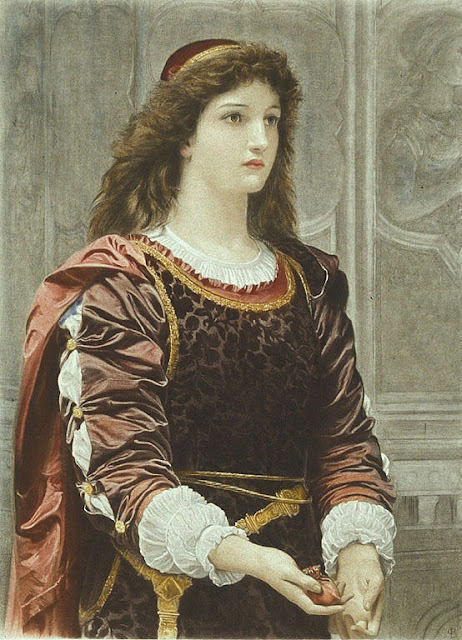CHARLES EDWARD PERUGINI
(1839-1918)
Born in Naples in 1839 he spent the first 25 years of his life growing up and studying art in Italy. By 1855 Perugini had made the acquaintance of the great British Neo-Classical artist Frederic Leighton who was traveling and studying on the Continent. A strong friendship developed between the two and Leighton took the young artist under his wing… giving him great encouragement and financial support.
By the late 1850’s Perugini left for England – accompanied by Leighton. Upon his arrival he worked in Leighton’s studio, but soon set up his own atelier and by 1863, the year he exhibited his first work at the Royal Academy, he was living and working at 13 Sutherland Terrace. Through Leighton’s social connections the young Italian artist gained access to many of the wealthy patrons in England, enabling him to achieve great financial success. His works were admired and collected by many and he received favorable remarks from the critics. A writer for the Art Journal of 1874 made the following comments about the work he exhibited at the Royal Academy that year:
There is much grace showing itself in A Cup of Tea, as well in the carefully drawn figure of a lady who sips the cup of tea as in the general harmony of color secured for the whole composition. Mr. Perugini understands the sense of rich effect in setting the creamy tints next the flesh, and in banishing almost entirely the colder colors.
Among his many acquaintances was Kate Dickens (1839-1929), the daughter of Charles Dickens. Kate, an artist herself, was married to the historical painter Charles Allston Collins and their marriage lasted until Collins’ death in 1873. Soon after, her friendship with Perugini blossomed and the two artists were married.
Throughout his career, Perugini continued to paint portraits and genre paintings that displayed his love for the ancient times in Greece and Rome and a great influence from Leighton and his fellow Neo-Classical artists. Among his most notable works are: Pompeian Interior (RA, 1870); Fresh Lavender (RA, 1878); Dolce far Niente (RA, 1882); Pandora (RA, 1893); A Willing Slave (RA, 1900) and The Green Lizard (RA, 1902).
The death of Mr Charles Edward Perugini which occurred in London yesterday, removes the last of the inner circle of intimates which included Leighton and Millais and formerly Fred Walker among the art-representatives of the recent past. He was born in Naples on September 1st 1839, during a short visit to that city by his Italian parents, who had for many years previously been resident in England, and he was still an infant when he was brought to this country, where in due course he became naturalized. Eleven years later Horace Vernet on seeing the boy’s drawings, recommended that he should study in Italy. He was successively the pupil of [Guiseppe] Bonolis and [Guiseppe] Mancinelli under whose severe training he became proficient in all the allied arts and architecture.
While still a youth he entered the studio in Paris of Ary Scheffer [in 1854]. At that time one of the greatest artistic figures in France and a friend of Louis-Phillipe. Curiously enough he was in Scheffer’s studio when Charles Dickens was sitting for his portrait accompanied by his young daughter Kate, whom the young artist did not see, but who was destined to become his wife a few years later. He soon attracted attention in the Royal Academy, where his engaging art brought him many admirers; among his best known pictures still familiar enough through the engravings made of them are Dolce far Niente, A Siesta, Cup of Tea, Fresh Lavendar, La Superbe, Flower Worship, and The World Forgetting.
Mr Perugini was also an occasional portrait painter; his likeness of John Forster, Charles Dickens’s biographer was re-exhibited not long since on the walls of the Victoria and Albert Museum. Although an Englishman in thought and character, Perugini showed himself in his art an inheritor of the tradition of Raphael, or rather of Carlo Dolci. Elegance, purity, and correctness of draughtsmanship, perfect refinement and dignity, grace and charm, delicacy in colour, and the tenderness of harmonious line - these are the qualities of his academic art which are now, it must be recognised outside, the sweep of the modern movement, but which has delighted two generations of picture-lovers who look for sound scholarship severely disciplined and veiled by melodious sweetness and distinction. His pictures are to be found in a number of public galleries. Perugini’s art reflected his nature. He commanded the respect and esteem of a large circle, and was regarded with particular attention by his friends, who will acutely feel the loss of so worthy and loveable a man.
It may be added that in the early days Mr Perugini received a commission in The Artists Rifle Corps of the Middlesex Royal Volunteers, afterwards the 20th, which he held for a good many years. He was a diligent and highly successful competitor in the chess-problem columns of The Times.

























ليست هناك تعليقات:
إرسال تعليق